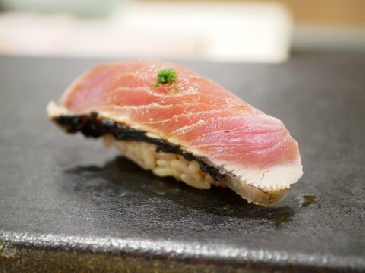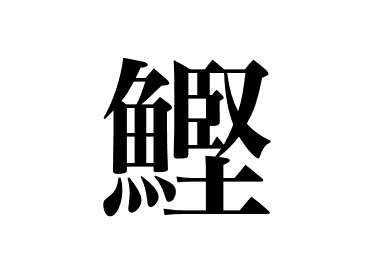Red flesh


Bonito (Katsuo)
【Nigiri sushi: Akami】
What is Bonito (Katsuo)?
Katsuo (Bonito) is widely distributed in tropical to temperate waters throughout the world. In Japan, Katsuo (Bonito) is abundant on the Pacific Ocean side and the west coast of Kyushu, and is rare in the Sea of Japan. Body shape is spindle-shaped, with a dark blue back and silvery-white abdomen, and several black longitudinal stripes along the sides of the body. However, these stripes appear after death. The length of the body can reach 1 meter. It was not until the Kamakura period that it came to be eaten raw, and was enjoyed as sashimi by samurai, commoners, and aristocrats alike. It is also called Hongatsuo or Magatsuo to distinguish it from Hirasouda, Marusouda, and Hagatsuo.
Katsuo-no-tataki (Seared Bonito) is a specialty of Tosa. The skinned flesh is skewered and roasted on the outside over a straw fire, then cooled in cold water. Sprinkle with ginger, green onions, and other condiments and citrus juices, then lightly tap with the back of a knife to blend the flavors, hence the name of the dish.
Bonito that are heading up north along the Japanese islands called Noborigatsuo (上り鰹) or Hatsugatsuo (初鰹), which has a moderate amount of fat and light taste. Bonito that are going down south are Modorigatsuo (戻り鰹) or Kudarigatuso (下り鰹), very fatty and best eaten with green long onions and ginger. It loses freshness easily, so it was not used for sushi until after the Showa Period began.
Grained ginger served together with bonito fish is common to get rid of the smell of bonito fish. However the bonito fish in great condition matches with various flavors such as karashi mustard and wasabi. Recently there are more places that serve bonito fish with karashi mustard.
Also called Arctic bonito or Ocean bonito or Skipjack or Striped bellied bonito or Watermelon.
What is Mayoigatsuo (迷い鰹)?
Bonito (katsuo) really don’t like to be in seawater with low salinity. The salinity of inner bays fluctuates depending on the size and number of rivers that flow into them, and fish that dislike freshwater would never go near brackish water areas (inner bays and estuaries). It is said that it is hard for bonito to go into the Sea of Japan. This is probably because from May to August, the peak season for China’s Yellow River and Yangtze River flows, seawater mixed with freshwater spreads in the Sea of Japan. Naturally, the freshwater comes into the Sea of Japan via ocean currents, so the freshwater-hating bonito avoid entering the Sea of Japan. However, the bonito that strayed from their school, that were supposed to migrate north in the Pacific Ocean before May, head north in the Sea of Japan. These are called “Mayoigatsuo”. “Mayoi” means “lost” in Japanese and “gatsuo” comes from the Japanese word for bonito. They are caught in fixed shore nets aiming for buri from the second half of November. The meat is firm and it has ample fat for traveling in the cold Sea of Japan waters. It also has a rich flavor and strong sweetness. The number of Mayoigatsuo caught is small and the volume supplied to the Toyosu market is less than 10% of that of in-season bonito, so the price is incomparably more than that of the spring and autumn bonito.
【Substitute fish】
Slender tuna: Allothunnus fallai Serventy, 1948
【Trivia】
Along with disk abalone, bonito cannot be judged by its quality by appearances. Whether it is thin or fat, you won't know until you actually cut it open. Especially around April, its quality changes dramatically each day.
【Related contents】
What is Mochigatsuo?
Quality Improvement of Frozen Bonito
What is Katsuobushi?
What is Black skipjack (Suma) sushi?
What is Slender tuna?
What is Toro Katsuo (Torogatsuo)?
Why are two pieces of nigiri sushi made at once?
Condiments for sushi
List of Red flesh fish (Akami)
(Revision date: December 30, 2023)
Main production area
Kochi Wakayama Chiba
Famous production area
Season
Spring・Autumn

